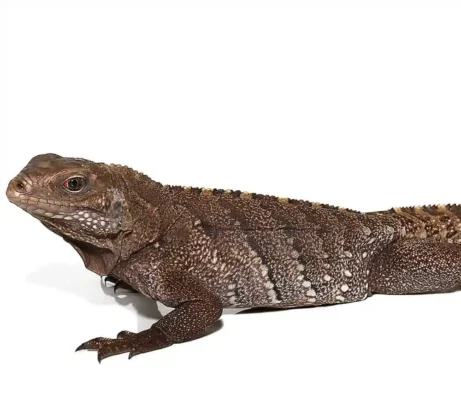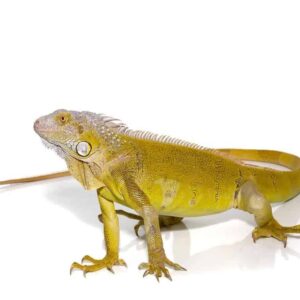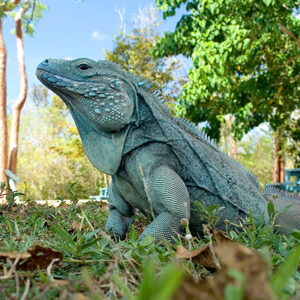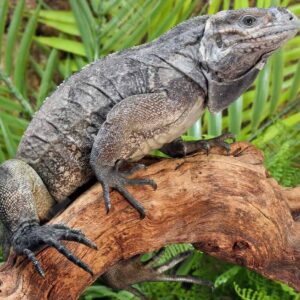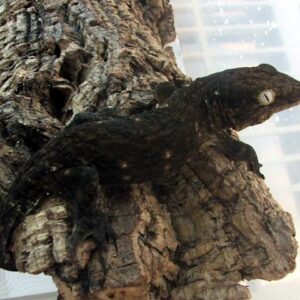Cayman Brac Iguana For Sale
$749.99
WE HAVE CAYMAN BRAC IGUANA FOR SALE. HERE ARE SOME HIGHLIGHTS:
- Cyclura nubila caymanensis
- U.S. Captive Bred Right Here At Sunset Reptiles
- Approximately 15 – 16 Inches From Head To Tail
- This Is An Extremely Smart Species That Makes For An Awesome Pet
- Not Commonly Seen, Now Available To You As Part Of Our Own Home-Grown Pristine Stock
- Voracious Herbivores Feeding On An Array Of Mixed Veggies And Fruits
FUN FACTS!
- Naturally Occurring In The Cayman Islands Just South Of Cuba In The Caribbean Sea
- Can Live Up To 60 Years In Captivity With Proper Care
- Adults Are Averaging In Sizes Around 4-5 Feet In Length
- Living Their Lives Along The Tropical Islands These Iguanas Thrive In Hot Humid Climates
Description
The Cayman Brac Iguana, scientifically known as Cyclura nubila caymanensis, is a remarkable and endangered species indigenous to the island of Cayman Brac in the Cayman Islands. This iguana is a subspecies of the Cuban rock iguana and is distinguished by its robust body, rough scales, and a prominent crest of spines running down its back. Typically, the Cayman Brac Iguana displays a grayish hue with subtle blue undertones, a coloration that aids in its camouflage within the island’s rocky terrain.
Reaching up to five feet in length and weighing around 15 pounds, the Cayman Brac Iguana is a significant component of the local ecosystem. Its diet primarily consists of fruits, flowers, and leaves, which play a crucial role in seed dispersal and vegetation dynamics on the island. The iguana is also an important prey species for local predators, thus maintaining the ecological balance.
The significance of the Cayman Brac Iguana extends beyond its ecological role. It is a symbol of the island’s natural heritage and an indicator of the health of its environment. However, the species faces numerous threats, including habitat destruction, invasive species, and human activities, leading to its classification as endangered. Understanding and conserving the Cayman Brac Iguana is imperative not only for the preservation of biodiversity but also for the cultural and natural legacy of the Cayman Islands.
Efforts to protect this unique iguana are vital, encompassing habitat restoration, legal protection, and public education. By fostering awareness and involvement, both locals and visitors can contribute to the enduring survival of the Cayman Brac Iguana, ensuring that this fascinating reptile continues to thrive in its native habitat for generations to come.
Habitat and Distribution
The Cayman Brac Iguana, a distinct species of rock iguana, finds its natural habitat within the unique ecosystems of Cayman Brac. This island, part of the Cayman Islands, provides an environment that is crucial for the survival of this iguana. The species thrives primarily in dry forests and limestone rocky terrains, where the climate and geological features offer optimal conditions for their sustenance and reproduction.
Dry forests on Cayman Brac feature a mix of shrubs, small trees, and ground cover plants, forming a diverse habitat. These forests provide the iguanas with ample food sources, including leaves, flowers, and fruits. The rocky terrains, on the other hand, are equally essential, offering shelter and basking sites. The crevices and caves in the limestone rocks protect the iguanas from predators and extreme weather, making these areas indispensable for their daily activities and overall survival.
The distribution of the Cayman Brac Iguana is notably limited, restricted mainly to the island of Cayman Brac. This confined range can be attributed to several factors. Firstly, the geographical isolation of Cayman Brac limits the natural migration of species, thereby confining the iguanas to this specific locale. Secondly, the specialized habitat requirements of the iguanas mean they are well-adapted to the island’s unique environment but may struggle to survive elsewhere. Additionally, human activities and habitat destruction have further constrained their range, making conservation efforts on Cayman Brac critical for their continued existence.
Understanding the habitat and distribution of the Cayman Brac Iguana is essential for effective conservation strategies. By preserving the dry forests and rocky terrains of Cayman Brac, we can ensure that these extraordinary creatures continue to thrive in their natural environment, maintaining the ecological balance of the island.
Diet and Feeding Habits
The Cayman Brac Iguana, known for its herbivorous diet, primarily consumes a wide variety of plants and fruits that are abundant in its natural habitat. Its feeding habits are integral to the health of its ecosystem, particularly due to its role in seed dispersal. By consuming fruits and subsequently excreting the seeds, the iguana aids in the propagation of numerous plant species, contributing to the biodiversity of Cayman Brac.
Among the favored food sources of the Cayman Brac Iguana are leaves, flowers, and fruits from native plants. This includes species such as the wild papaya, sea grape, and various types of cacti. These food items provide the essential nutrients required for the iguana’s growth and overall well-being. The Cayman Brac Iguana’s diet is also influenced by the availability of these plants, which can fluctuate with the seasons.
During the wet season, when plant growth is at its peak, the iguana has access to a more diverse and plentiful food supply. This period allows the iguana to consume a variety of fresh leaves and succulent fruits, which are rich in water content, helping to keep the iguana hydrated. Conversely, in the dry season, the availability of these food sources diminishes, prompting the iguana to rely more on drought-resistant plants and fruits that can withstand harsher conditions.
Foraging for food is a daily activity for the Cayman Brac Iguana. It exhibits a remarkable ability to locate and consume a wide array of plant materials, ensuring it meets its dietary needs. This foraging behavior not only sustains the iguana but also supports the broader ecological community by fostering plant growth through seed dispersion.
In essence, the Cayman Brac Iguana’s diet and feeding habits are crucial not only for its survival but also for maintaining the ecological balance of its habitat. The interplay between the iguana and its environment highlights the importance of preserving this unique species and its natural surroundings.
Reproduction and Lifespan
The reproductive behavior of the Cayman Brac Iguana is a captivating aspect of their biology. Mating typically occurs during the warmer months, when males engage in elaborate displays to attract females. These displays often include head bobbing, dewlap extensions, and tail flicking, which serve to establish dominance and courtship. Once a pair forms, the female selects a suitable nesting site, often preferring sandy or loose soil where she can dig a burrow to lay her eggs.
Nesting usually takes place between May and June. The female lays a clutch of 5 to 20 eggs, which she then carefully buries to ensure protection from predators and environmental conditions. The incubation period for Cayman Brac Iguana eggs averages around 70 to 90 days, depending on temperature and humidity levels. During this period, the eggs are highly vulnerable, and only a fraction of them will successfully hatch due to predation and other natural factors.
Once hatched, juvenile iguanas face numerous challenges in their early stages of development. Survival rates for juveniles are relatively low, as they are preyed upon by various predators, including birds, snakes, and larger reptiles. Those that do survive grow rapidly, reaching sexual maturity at around three to four years of age. This early development stage is crucial, as it determines the iguana’s overall chances of reaching adulthood and contributing to the population.
In the wild, the Cayman Brac Iguana has an average lifespan of 20 to 30 years, although some individuals have been known to live longer under optimal conditions. Factors influencing their longevity include availability of food resources, habitat quality, and the presence of predators. Conservation efforts play a significant role in enhancing the survival and longevity of these iguanas, as habitat destruction and invasive species present ongoing threats to their populations.
Understanding the reproductive and lifespan characteristics of the Cayman Brac Iguana is essential for developing effective conservation strategies. By protecting nesting sites and mitigating threats, we can help ensure the continued survival of this remarkable species in its natural habitat.
Conservation Status and Threats
The Cayman Brac Iguana, a unique reptile endemic to the Cayman Brac island, is currently classified as endangered. This alarming conservation status is a result of multiple threats that have significantly impacted their population. Habitat destruction stands as the primary threat, driven by expanding human development, agriculture, and tourism infrastructure. The iguana’s natural habitat is fragmented, reducing available nesting sites and food sources, which are crucial for their survival.
Invasive species also pose a severe risk to the Cayman Brac Iguana. Predators such as feral cats and dogs prey on juvenile iguanas, while invasive plants outcompete native vegetation, further diminishing the iguanas’ food supply. Additionally, invasive rats are known to raid nests, destroying eggs and thereby directly impacting reproductive success. These ecological disruptions create an environment where the iguanas struggle to thrive.
Human activities, including unregulated hunting and road mortality, exacerbate these threats. Some individuals are targeted for the illegal pet trade, reducing the already dwindling population. Furthermore, roads that intersect their habitat increase the chances of vehicle collisions, leading to fatalities. These anthropogenic pressures necessitate immediate and effective conservation measures.
Efforts to protect and conserve the Cayman Brac Iguana are underway, both locally and internationally. Local conservation programs, spearheaded by dedicated wildlife organizations, focus on habitat restoration, predator control, and public education campaigns to raise awareness about the iguana’s plight. These initiatives aim to create safe havens where the iguanas can breed and thrive without external pressures.
On an international level, partnerships with global conservation entities provide additional support through funding, research, and expertise. These collaborations facilitate the implementation of comprehensive conservation strategies, including captive breeding programs and genetic studies, to ensure the long-term survival of the species. With concerted efforts, there is hope for the recovery and preservation of the Cayman Brac Iguana for future generations.
Role in the Ecosystem
The Cayman Brac Iguana plays a pivotal role in maintaining the ecological balance of its native environment. This species is integral to the health of its habitat, primarily through its contributions to seed dispersal and vegetation management. As these iguanas consume a variety of fruits, they inadvertently aid in the distribution of seeds across the island. This natural process ensures the propagation of diverse plant species, fostering a robust and varied plant community that supports other wildlife.
Moreover, the Cayman Brac Iguana’s grazing habits help regulate vegetation growth. By feeding on specific plants, they prevent any single species from becoming overly dominant, thus promoting a balanced ecosystem. This vegetation management ensures that the habitat remains suitable for various other species, including birds, insects, and smaller reptiles. The interconnectedness of these species forms a complex food web, where the iguana’s role is crucial for overall stability.
The decline in the population of the Cayman Brac Iguana could have significant repercussions on the ecosystem. A reduction in seed dispersal activities would lead to decreased plant diversity, which, in turn, could affect the availability of food and shelter for other organisms. Additionally, without the iguana’s grazing, certain plant species might proliferate unchecked, altering the habitat structure and potentially displacing other species.
In essence, the Cayman Brac Iguana’s ecological role is multifaceted and vital for the health of its environment. Protecting this species is not just about preserving a single animal but about maintaining the intricate balance of the ecosystem it helps sustain. The interconnected nature of life on Cayman Brac underscores the importance of every species, with the iguana being a keystone component of this delicate and vibrant ecosystem.
Human Interaction and Cultural Significance
The Cayman Brac Iguana, also known as the Sister Islands Rock Iguana, holds a unique place in the hearts and culture of the local population on Cayman Brac. This remarkable reptile is not just an ecological treasure but also a symbol of the island’s natural heritage. For many residents, the Cayman Brac Iguana embodies resilience and continuity, reflecting the island’s rich natural history and the community’s commitment to preserving its unique biodiversity.
Local folklore and traditional stories often feature the Cayman Brac Iguana, highlighting its importance in the cultural narrative. Elders recount tales of the iguanas roaming freely, unbothered by human presence, serving as a living reminder of the island’s pristine past. These narratives are integral in fostering a sense of pride and responsibility among the younger generation towards the conservation of this endangered species.
Eco-tourism initiatives play a crucial role in raising awareness and generating support for the conservation of the Cayman Brac Iguana. Guided tours and educational programs organized by local conservation groups and government agencies offer visitors a chance to observe these iguanas in their natural habitat. These initiatives not only enhance the visitors’ understanding of the iguana’s ecological significance but also emphasize the importance of preserving their environment. The revenue generated from eco-tourism is often reinvested into conservation projects, further aiding in the protection of the iguana’s habitat.
Educational initiatives are also instrumental in shaping public perception and engagement with conservation efforts. Schools on the island integrate lessons about the Cayman Brac Iguana into their curriculum, teaching students about the species’ role in the ecosystem and the threats it faces. These educational efforts aim to instill a sense of stewardship among the youth, encouraging them to participate actively in conservation activities.
Through these combined efforts, the Cayman Brac Iguana has become more than just a species to be protected; it has become a symbol of the community’s dedication to preserving its natural heritage. This relationship between the iguana and the people of Cayman Brac is a testament to the power of cultural significance and education in fostering successful conservation initiatives.
Future Prospects and Conservation Efforts
The future of the Cayman Brac Iguana, an endemic species with unique ecological significance, is closely tied to the effectiveness of ongoing and proposed conservation efforts. Currently, these efforts are focused on habitat restoration, threat mitigation, and population reinforcement. By improving the quality of their natural environment, conservationists aim to create sustainable habitats that can support larger populations of these remarkable reptiles.
One of the primary strategies involves the systematic removal of invasive species that pose a direct threat to the iguanas. Predators such as feral cats and rats have significantly impacted iguana populations by preying on their eggs and juveniles. Targeted eradication programs, combined with the establishment of predator-free zones, have shown promising results in enhancing iguana survival rates.
Another critical component of conservation efforts is habitat enhancement. This includes reforestation projects and the protection of existing forest areas, which are crucial for providing shelter and food resources. By planting native trees and shrubs, conservationists are working to recreate the iguanas’ natural habitat, thereby facilitating their return to a more balanced ecosystem.
Moreover, captive breeding programs have been instrumental in boosting iguana numbers. These programs involve the careful breeding of iguanas in controlled environments, followed by the release of healthy individuals into the wild. Success stories from similar initiatives for other iguana species, such as the Grand Cayman Blue Iguana, provide a hopeful outlook for the Cayman Brac Iguana’s future.
Despite these efforts, challenges remain. Continued habitat destruction, human encroachment, and climate change pose ongoing threats that require adaptive management strategies. Enhanced public awareness and community involvement are critical for the long-term success of these conservation initiatives. Encouraging local and international support can help secure the resources needed for sustained conservation activities.
Readers are encouraged to support conservation projects, whether through donations, volunteering, or simply spreading awareness about the plight of the Cayman Brac Iguana. By taking collective action, we can contribute to the preservation of this extraordinary species and ensure its survival for future generations.
